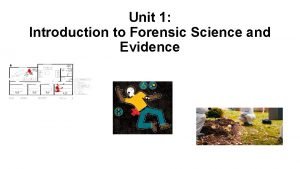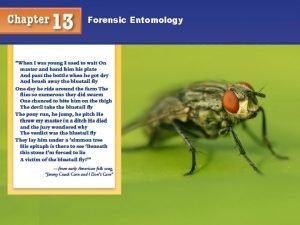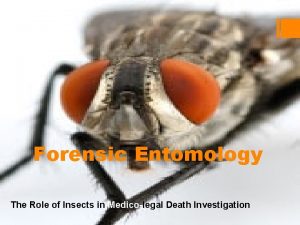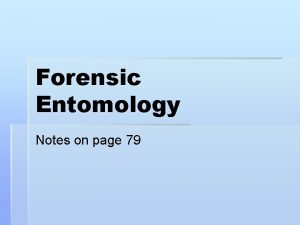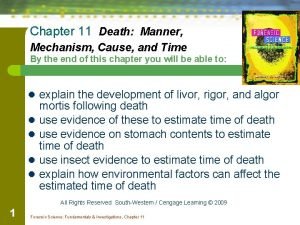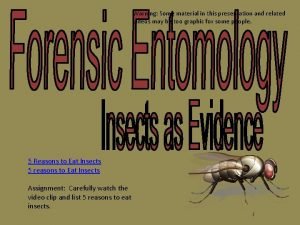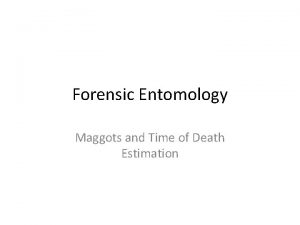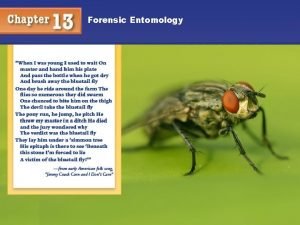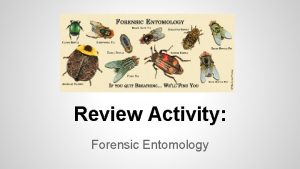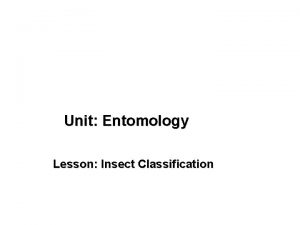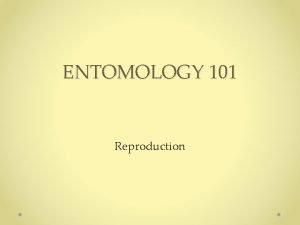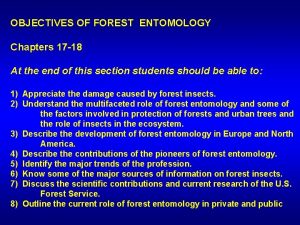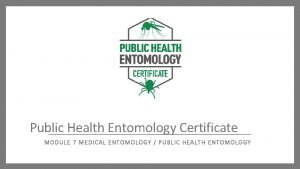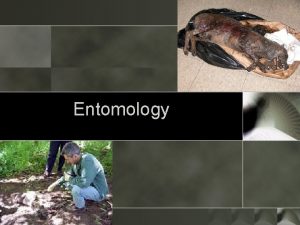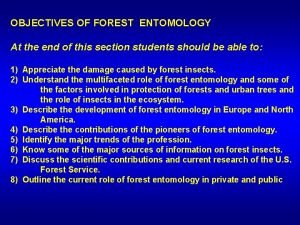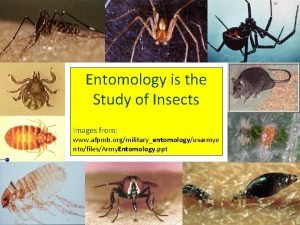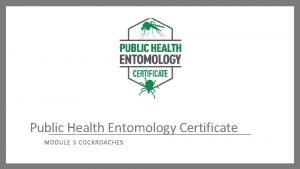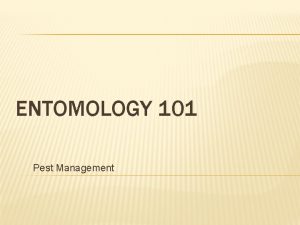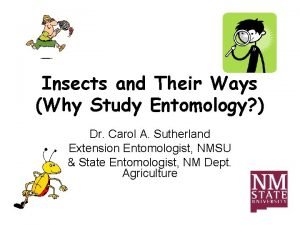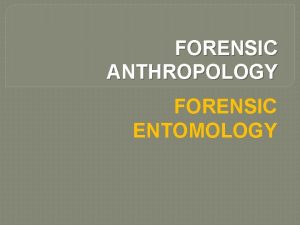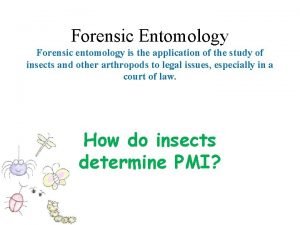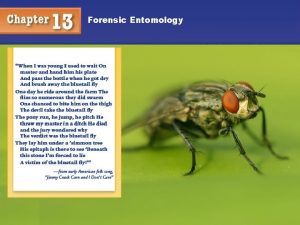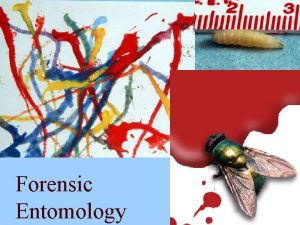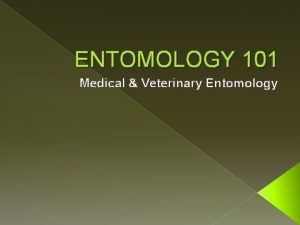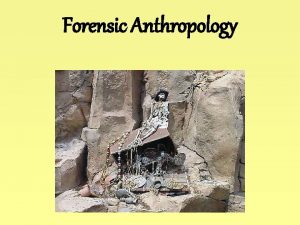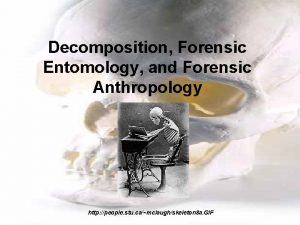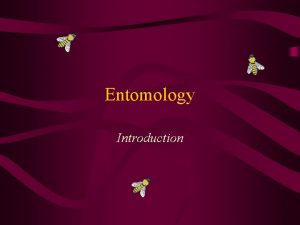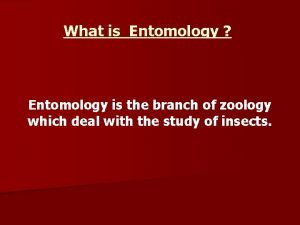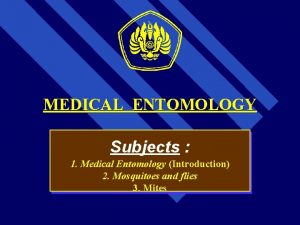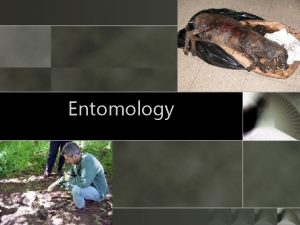Forensic Entomology Forensic entomology is the application of
































































- Slides: 64

Forensic Entomology Forensic entomology is the application of the study of insects and other arthropods to legal issues, especially in a court of law. How do insects determine PMI?

• http: //www. exploreforensics. co. uk/what-is-apathologist. html

Insects • Insects can provide detailed information about time of death in several ways. • There is an entire field dedicated to study insects called “Forensic Entomology”. • Within minutes of death, certain insects arrive to lay their eggs on the warm body, attracted by the smell of the first stages of decomposition. • The eggs will hatch and feed on the tissues. • Blowflies are a common example. • Flesh flies are another example.

• Post-mortem interval (PMI) is the time that has elapsed since a person has died. If the time in question is not known, a number of medical/scientific techniques are used to determine it. This also can refer to the stage of decomposition of the body

• Do Now: Diatom Detective • http: //www. pbs. org/wnet/nature/episodes/crimescene-creatures/video-diatom-detective/5208/ 1. What important information do microscopic organisms reveal about a crime? 2. How did the forensic scientist prove that the husband had been in the water of that stretch of the river?

History of Forensic Entomology: The Earliest Case • • Sung Tz'u (1235 AD) – Chinese “death investigator” Wrote The Washing Away of Wrongs First forensic entomology case recorded A murder by slashing occurred in a village, and the local death investigator was ordered to solve the crime. The investigator had all villagers bring their sickles to one spot and lay them out before the crowd. Flies were attracted to one of the sickles, probably because of invisible remnants of tissue still remaining on it, and the owner subsequently broke down and confessed to the crime.

Forensic Entomology Relies Strongly on the Following Ecological Concepts • Developmental time is temperature dependant at the microhabitat level. • Ecological succession – A corpse will be invaded by a series of different species or insect groups over time. Each species or group changes the microenvironment through its activities which makes it attractive to new waves of organisms and so on. • What other important information do the insects provide?


Examples of Diptera (Flies) Early Stage Decomposition Blow & Greenbottle Flies (Calliphoridae) Flesh Fly (Sarcophagidae) Striped thorax Metallic thorax and abdomen Life Cycle of a Calliphoridae Fly Late Stage Decomposition House Fly (Muscidae) Cheese Skipper (Piophilidae) Informational Source: http: //naturalsciences. org/files/documents/csi_tg_overview. doc Images: Top Left - http: //www. scienceinschool. org/repository/images/issue 2 forensic 3_large. jpg, Middle-Left: http: //forensicfact. files. wordpress. com/2008/04/blowfly 053. jpg, Top Right - http: //users. usachoice. net/~swb/forensics/P 1. jpg, Bottom - http: //www. deathonline. net/decomposition/corpse_fauna/flies/index. htm

Examples of Coleoptera (Beetles) Early Stage Decomposition Early to Late Stage Decomposition Carrion Beetles (Silphidae) Rove Beetles Clown Beetles (Staphylinidae) (Histeridae) Adults & larvae feed on fly larvae Predator of fly eggs Late Stage Decomposition Ham & Checkered Beetles (Cleridae) Predator of flies & beetles; also feed on dead tissue Predator of fly eggs Hide Beetles Skin Beetles (Dermestidae) Feed on dried skin & tissues Informational Source: http: //naturalsciences. org/files/documents/csi_tg_overview. doc (Scarabidae) Usually the last to arrive Images: http: //www. cals. ncsu. edu/course/ent 425/library/spotid/coleoptera. html & http: //www. forensicflies. com/beetles. htm

What do they do? Forensic entomologists apply their knowledge of entomology to provide information for criminal investigations. A forensic entomologist’s job may include: • Identification of insects at various stages of their life cycle, such as eggs, larva, and adults. • Collection and preservation of insects as evidence. • Determining an estimate for the postmortem interval or PMI (the time between death and the discovery of the body) using factors such as insect evidence, weather conditions, location and condition of the body, etc. • Testifying in court to explain insect-related evidence found at a crime scene. Did you know? Maggots can be used to test a corpse for the presence of poisons or drugs. Some drugs can speed up or slow down the insect’s development. Cool Jobs: Forensic Entomology Discovery Video

Insects as Evidence Forensic entomologists use their knowledge of insects and their life cycles and behaviors to give them clues about a crime. Blow Fly Carrion Beetle Most insects used in investigations are in two major orders: 1 – Flies (Diptera) and Species succession may 2 – Beetles (Coleoptera) also provide clues for investigators. Some species may to feed on a fresh corpse, while another species may prefer to feed on one that has been dead for two weeks. Investigators Images: Top Right - http: //www. insectinvestigations. com/aboutfe. htm, Chart - http: //www. clt. uwa. edu. au/__data/page/112507/fse 07_forensic_entomology. pdf

Blowflies • One of the first insects to arrive at a dead body. • Very useful in determining the TOD. • They exhibit different stages as they develop from eggs, larva (also known as instars), pupa and adult.

• Blowflies are attracted to two gases of decomposition: – Putrescine – Cadaverene • As the corpse progresses through the stages, other kinds of insects will arrive. – Tiny wasps come to lay their eggs on maggots already present in the body – Cheese skippers arrive once putrefaction is underway; they are attracted by the seepage of body fluids. – Mites and beetles feed on dry tissues and hair.

Interactive Insect Activity http: //www. pbs. org/wnet/nature/ep isodes/crime-scenecreatures/interactive-determine-the -time-of-death/4390/

Weather data is also an important tool in analyzing insect evidence from a corpse. Investigators will make note of the temperature of the air, ground surface, the interface area between the body and the ground, and the soil under the body as well as the temperature inside any maggot masses. They will also collect weather data related to daily temperature (highs/lows) and precipitation for a period of time before the body was discovered to the time the insect evidence was collected. • Other factors that might affect their PMI estimates: 1. Was the body enclosed in an area or wrapped in a material that would have prevented flies from finding the corpse and laying eggs? Did you know… 2. insect species present thatismay have affected the The. Were “Bodyother Farm” in Knoxville, Tennessee development of the collected a university research facility tospecies? investigate Click the image to view a human decomposition under 3. Were there drugs or other poisonsvarious in or on the body that might video about the Body Farm! conditions in order understand the factors have affected thetolarvae’s development?

Blow Fly Life Cycle

Blow Fly Metamorphosis Blow flies are attracted to dead bodies and often arrive within minutes of the death of an animal. They have a complete life cycle that consists of egg, larva, pupa, and adult stages. Adul 1 st – Adult flies lay eggs on the carcass especially at wound areas or around the openings in the body t such as the nose, eyes, ears, anus, etc. Pup Egg 2 nd – Eggs hatch into larva (maggots) in 12 -24 a s hours. 3 rd– Larvae continue to grow and molt (shed their exoskeletons) as they pass through the various instar stages. 1 st Instar - 5 mm long after 1. 8 days 2 nd Instar - 10 mm long after 2. 5 days 3 rd Instar – 14 -16 mm long after 4 -5 days 4 th – The larvae (17 mm) develop into pupa after burrowing in surrounding soil. 5 th – Adult flies emerge from pupa cases after 6 -8 days. 1 st Inst 2 nd ar Instar Larv It takes approximately 14 -16 days from egg to Larva a adult depending on the temperatures and 3 rd Instar Larva Image: http: //www. umext. maine. edu/images/Fly. Life. jpg Information: http: //www. kathyreichs. com/entomology. htm and http: //www. forensicentomologist. org/ humidity levels at the location of the body.

• Soon after Death—blowfly eggs can be Egg found in the moist, warm areas of a corpse – < 8 hrs

Larva Stages 1 (Instar 1) • Within 20 hours

• After 2 ½ days Larva 2 (Instar 2)

Larva Stage 3 (Instar 3) • After 4 -5 days

• After 8 -12 days Pre-Pupa

• After 18 -24 days Pupa

• After 21 -24 days Adult

Time of Death—Insects o o o The insect life cycle provides scientists with a benchmark to estimate a time of death Insect evidence cannot provide an exact time of death—fluctuating environmental conditions Insect evidence provides a close estimate

Thermal Energy and Accumulated Degree Units • In order to advance to the next growth stage, an insect requires a certain amount of thermal (heat) energy. • The insect will receive more thermal energy as time passes. • Each day that an insect is feeding and living on a body, it will receive more thermal energy from its environment. • We can determine how much thermal energy that an insect has received in a day by multiplying the environmental temperature by the number of hours in a day. • We call these heat units, accumulated degree hours (ADH)

For example, if the average temperature on a given day is 70°F, then after one full day (24 hours), the insect will have received 1, 680 heat units. Temperature X Number of hours = Total heat units in hours 70°F X 24 hours = 1680 ADH

Table 1: Accumulated Degree Day Calculations Example 1 Average ADH Accumulated ADD Calculation Day Temp. Calculation Degree Hours (Add up ADH values) July 1 July 2 July 3 July 4 July 5 July 6 July 7 1872 + 0 (ADD for 1 Accumulated Degree Days 78 78° X 24 1872 80 80° X 24 1920 1872 + 1920 3792 85 85° X 24 2040 3792 + 2040 5832 76 76° X 24 90 83 74 day) 1872

We can use accumulated degree days to assist in PMI estimation because fly life cycles are predictable and have been documented through rigorous scientific experimentation. Black blow flies will grow in environments with temperatures between 55°F and 95°F. The insect will only advance to the next stage in the life cycle after receiving a given amount of thermal energy. Table 2 below provides information about the amount of thermal energy needed for a blow fly at each stage of development. Table 2: Estimated Thermal Energy Requirements for the Life Cycle of the Black Blow Fly Stage in the Life Cycle Thermal Energy Required (ADD) Egg Less than 950 1 st Instar 950 - 1770 2 nd Instar 2, 280 - 4, 484 3 rd Instar 3, 990 - 9912 Pupa 15, 010 - 23, 364 Adult Fly 33, 440 – 38, 468

Let’s give it a try … Click the image above or click here to visit the website at http: //www. pbs. org/wnet/nature/episodes/crime-scene-creatures/interactive-determine-the-time-of-death/4390/

The Most Common Application Relates to Death Investigations • • Determining PMI – postmortem interval Movement of the corpse. Manner and cause of death In how many ways insect populations would be indicative of the fact that someone died of stab wounds vs by heart attack, or some other disease? Justify your explanation. Association of suspects with the death scene How can this factor affect insect populations? Detection of toxins or drugs through analysis of insect larvae How can that help in forensic science?

Estimates of PMI Using Insects May Be Based On: • Period of time for a given species to reach a particular stage of development • Comparisons of assemblages of insect fauna on corpse at time of examination • A combination of both above

How do Entomologists use Corpse Fauna to Estimate Time of Death? Can maggots infest a living human body? http: //www. dailymail. co. uk/health/article-2833454/Thevideo-make-skin-crawl-Man-develops-maggot-infestation -EAR-housefly-lays-eggs-asleep. html Do: Now: From Eggs to Maggots http: //www. pbs. org/wnet/nature/episodes/crime-scenecreatures/video-from-eggs-to-maggots/5209/ • What are some factors that affect the “fly clock”? • Based on feeding habits, what types of insects do you think would constitute corpse fauna?

Ecological Roles of Insects in Decompositon • Necrophages – species feeding on corpse tissue; mostly true flies and beetles; age determination (larval instar) important for PMI • Omnivores – insects that feed both on the corpse and associated fauna; ants, wasps and some beetles; may alter rate of decomposition. • Parasites and Predators – many beetles, true flies and wasps that attack immature flies • Incidentals – use the corpse as a resource extension; springtails, spiders, centipedes, some mites.

Five Stages of Human Decomposition Have Been Recognized • Stage One - Fresh Stage (Days 1 -2) • Livor, Rigor, Algor mortis • First sign of bloating due to putrefaction by anaerobic bacteria • Autolysis- cellular breakdown • Some blistering at the skin surface • Flesh flies, blow flies, ants eating fly eggs and predatory wasps

Flesh Flies – 2 Species

Two Blowfly Species

Blowfly Larvae

House Flies on Dead Host

The abscess on the hind leg of the pig is getting some attention from blowflies looking to deposit eggs on the swollen mass (left). Blowflies are present on the carcass, but maggots are mostly active on the face (right)

Five Stages … • Stage two - Bloated stage (Days 2 -6) • putrefaction begins; gases such as hydrogen sulfide, carbon dioxide, and methane produced by anaerobic bacteria resulting in considerable bloating • seepage of fluids from orifices, such as mouth, nose, and anus • Tissue may become frothy • adult and larval blowflies attracted in large numbers to seepage • Maggots have hatched and begun to feed on the tissue • Purging of gases and fluids results in strong decay odors • soil fauna moves away due to wetness of earth; ants and other species of flies prey on maggots

Bloated unidentified animal on Long Island Shore

Blowfly activity on the carcass; skin is sloughing off the bloated pig

Most egg masses are on the head and neck and appear as thick white clumps on the carcass. Close up of a large egg mass on the cheek with adult blow fly; maggots feeding in mouth and nose.

Five Stages … Stage three - Decay Stage (Days 5 -11) • Period of greatest mass loss resulting from the voracious feeding maggots and the purging of fluids • The purged fluids accumulate around the body and create a cadaver decomposition island (CDI) • Abdominal wall is broken and carcass deflates; adult flies begin to leave the body to pupate, but great masses of maggots remain and feed • carcass will begin to dry and beetles begin feeding on drier tissue; • predatory beetles such as rove and hister beetles are attracted • Strong decay odor persists

Pig Carcass Infested With Blowfly Maggots

Cadaver Decomposition Island (CDI)

Hister Beetles Prey on Blowfly Larvae

Rove Beetles – 2 Species

Carrion Beetles decomposing the carcass of a dead animal

Five Stages … Stage 4 • Stage Four - Post decay Stage (Days 10 -25) – in dry habitats - remains consist of dry skin, cartilage and bones; site for dermestid beetles, histerids, fly pupae, immature and adult rove beetles – in wet habitats – large quantities of wet, viscous material (byproducts of decomposition) found in soil under the remains; site for adult and immature moth flies, rove beetles

Pig carcass in advanced stage of decomposition

Dermestid Beetles – Adult and Larvae

Five Stages … • Stage Five - Dry Stage (Days 25+) – Mainly bone and hair is all that remains; odor is primarily that of soil and litter; some dermestids, fly pupae, immature and adult rove beetles, normal soil fauna consisting of mites, etc. start to return; this stage could last for several months to years. • Resurgence of plant growth around the CDI due to increased nutrients such as phosphorus, K, Ca, Mg, and C.

Carrion Beetles – 2 Species

Female Carrion Beetle and Kangaroo Rat will be completely buried and eggs laid upon it.

Skeletonized pig carcass showing the production of a cadaver decomposition island surrounding the remains as a result of leaching of decomposition fluids into the surrounding environment.

Barriers to Decomposition and Irregular Decomposition • Physical – soil, water, caskets, antermortem and postmotem injuries • Chemical – embalming agent, insecticides, lime, etc. • Climatic – heat, cold, wind, rainfall • Animals – bird, mice, rodents, canids, cats, etc.

Examples of Coleoptera (Beetles) Early Stage Decomposition Early to Late Stage Decomposition Carrion Beetles (Silphidae) Rove Beetles Clown Beetles (Staphylinidae) (Histeridae) Adults & larvae feed on fly larvae Predator of fly eggs Late Stage Decomposition Ham & Checkered Beetles (Cleridae) Predator of flies & beetles; also feed on dead tissue Predator of fly eggs Hide Beetles Skin Beetles (Dermestidae) Feed on dried skin & tissues Informational Source: http: //naturalsciences. org/files/documents/csi_tg_overview. doc (Scarabidae) Usually the last to arrive Images: http: //www. cals. ncsu. edu/course/ent 425/library/spotid/coleoptera. html & http: //www. forensicflies. com/beetles. htm

Watch the short Nature video “Pig in a blanket” http: //www. pbs. org/wnet/nature/ episodes/crime-scenecreatures/introduction/301/ • How did the forensic entomologist determine PMI from the files?

Interactive Insect Activity http: //www. pbs. org/wnet/nature/ep isodes/crime-scenecreatures/interactive-determine-the -time-of-death/4390/

• Forensic Entomologist Video • http: //news. discovery. com/h uman/videos/human-forensicentomologist. htm Question: What are some other applications of forensic entomology in addition to PMI?

• Catching Killers with Insects • http: //news. discovery. com/h uman/videos/human-forensicentomologist. htm
 Examples of transient evidence
Examples of transient evidence Phormia regina
Phormia regina What is it
What is it Pro corbis
Pro corbis Medicolegal forensic entomology
Medicolegal forensic entomology Forensic entomology notes
Forensic entomology notes Chapter 11 forensic entomology
Chapter 11 forensic entomology Anatomy of a maggot
Anatomy of a maggot How to calculate adh forensics
How to calculate adh forensics Body parts of housefly
Body parts of housefly What does pmi stand for forensics
What does pmi stand for forensics Who is this
Who is this Pathologist and anthropologist
Pathologist and anthropologist Classification of insects
Classification of insects Adh forensics
Adh forensics Entomology 101
Entomology 101 Father of forest entomology
Father of forest entomology Zoonotic diseases
Zoonotic diseases Entomology is the study of
Entomology is the study of Forest entomology definition
Forest entomology definition Decomposition
Decomposition Comparison context clue
Comparison context clue Public health entomology certificate
Public health entomology certificate Zoology branches
Zoology branches Entomology 101
Entomology 101 Why study entomology
Why study entomology Ng-html
Ng-html Voi kéo gỗ như thế nào
Voi kéo gỗ như thế nào Thiếu nhi thế giới liên hoan
Thiếu nhi thế giới liên hoan Các số nguyên tố là gì
Các số nguyên tố là gì Vẽ hình chiếu vuông góc của vật thể sau
Vẽ hình chiếu vuông góc của vật thể sau Các châu lục và đại dương trên thế giới
Các châu lục và đại dương trên thế giới Thế nào là hệ số cao nhất
Thế nào là hệ số cao nhất Sơ đồ cơ thể người
Sơ đồ cơ thể người Tư thế ngồi viết
Tư thế ngồi viết đặc điểm cơ thể của người tối cổ
đặc điểm cơ thể của người tối cổ Cách giải mật thư tọa độ
Cách giải mật thư tọa độ Bổ thể
Bổ thể Thang điểm glasgow
Thang điểm glasgow ưu thế lai là gì
ưu thế lai là gì Tư thế ngồi viết
Tư thế ngồi viết Thẻ vin
Thẻ vin Thơ thất ngôn tứ tuyệt đường luật
Thơ thất ngôn tứ tuyệt đường luật Cái miệng nó xinh thế
Cái miệng nó xinh thế Các châu lục và đại dương trên thế giới
Các châu lục và đại dương trên thế giới Từ ngữ thể hiện lòng nhân hậu
Từ ngữ thể hiện lòng nhân hậu Diễn thế sinh thái là
Diễn thế sinh thái là Ví dụ về giọng cùng tên
Ví dụ về giọng cùng tên Làm thế nào để 102-1=99
Làm thế nào để 102-1=99 Alleluia hat len nguoi oi
Alleluia hat len nguoi oi Tỉ lệ cơ thể trẻ em
Tỉ lệ cơ thể trẻ em Hươu thường đẻ mỗi lứa mấy con
Hươu thường đẻ mỗi lứa mấy con đại từ thay thế
đại từ thay thế Vẽ hình chiếu vuông góc của vật thể sau
Vẽ hình chiếu vuông góc của vật thể sau Quá trình desamine hóa có thể tạo ra
Quá trình desamine hóa có thể tạo ra Công của trọng lực
Công của trọng lực Hát kết hợp bộ gõ cơ thể
Hát kết hợp bộ gõ cơ thể Thế nào là mạng điện lắp đặt kiểu nổi
Thế nào là mạng điện lắp đặt kiểu nổi Các loại đột biến cấu trúc nhiễm sắc thể
Các loại đột biến cấu trúc nhiễm sắc thể Lời thề hippocrates
Lời thề hippocrates Vẽ hình chiếu đứng bằng cạnh của vật thể
Vẽ hình chiếu đứng bằng cạnh của vật thể độ dài liên kết
độ dài liên kết Môn thể thao bắt đầu bằng từ chạy
Môn thể thao bắt đầu bằng từ chạy Sự nuôi và dạy con của hươu
Sự nuôi và dạy con của hươu điện thế nghỉ
điện thế nghỉ
